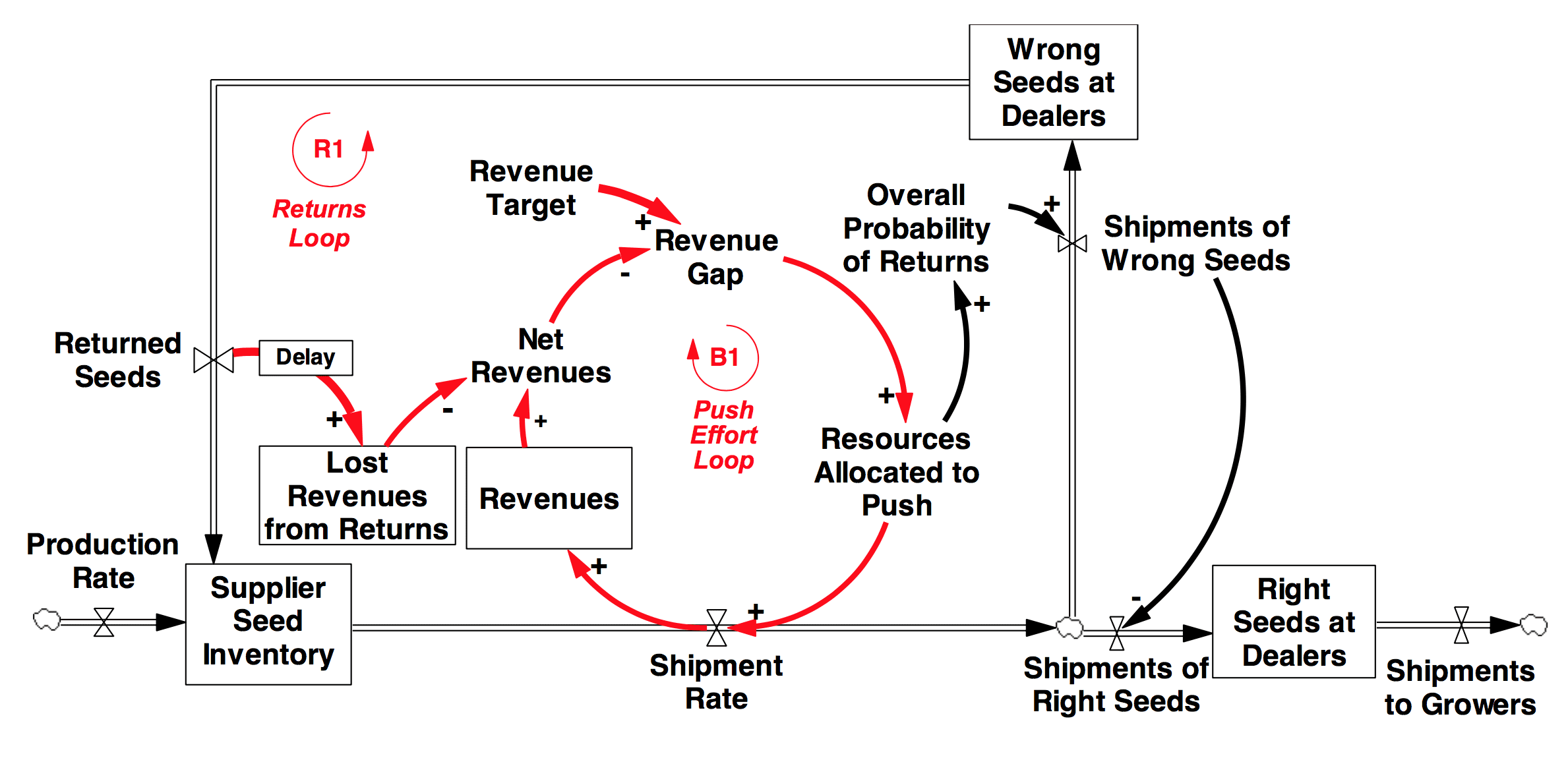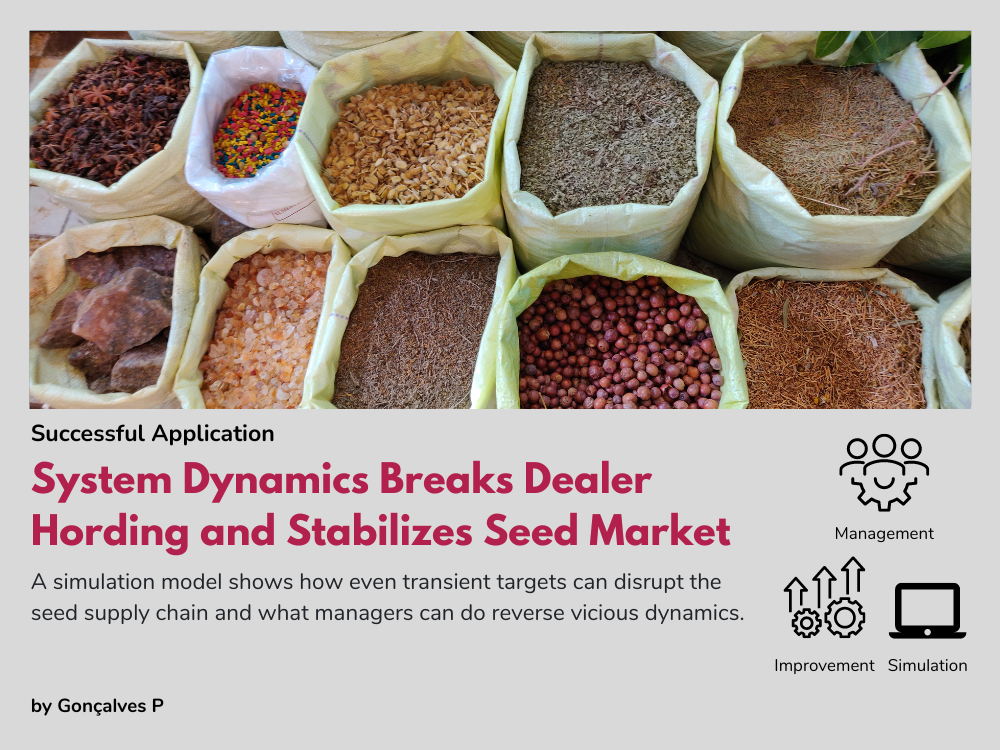System Dynamics Breaks Dealer Hording and Stabilizes Seed Market
The Issue You Tackled
Product returns are a common problem and generate significant costs. Much has been written about reducing returns by aligning buyer and seller incentives, and yet high levels of returns persist. To address why, we examined the interactions between a supplier and its dealers in the hybrid seed industry. Through an in-depth exploration of a seed supplier experiencing over 30% returns, we studied the complex interactions among the supplier, dealers, and growers in the industry. Our research revealed influences on returns from variables (e.g., salesforce size, sales targets) that have not been identified previously. In the seed supply chain, the supplier sells seeds to dealers, who then resell them to growers. Both supply and demand are highly uncertain, which can result in supply shortages. If supply is limited, dealers tend to overstock seeds, exacerbating shortages, and intensifying competition and hoarding among dealers. This behavior leads to seed stocks that are not adequately matched to grower demand, and causes high returns. Seed suppliers often encourage dealers to overstock seeds to achieve opportunistic sales or to limit competitors’ shelf space. While there are short-term benefits associated with overstocking to gain additional sales from growers, the cost associated with excessive returns may, at times, far outweigh them.
What You Actually Did
Our research builds on interviews and direct observations to provide information on key variables (e.g., sales effort allocation), their interdependences (e.g., pressure and effort allocation), critical feedback processes (e.g., from sales effort allocation, to returns, to sales targets and next period effort allocation), and managers’ decision making process (e.g., dealers’ orders). Review of secondary data, company documents, standard operating procedures, helped us detail the physical features (e.g., shipments, level of returns, sales targets) of our model. We uncovered supplier driven influences (e.g., supplier’s salesforce size, recovery targets) on returns that have not been identified previously in Operations Management literature. We explored the impact of these influences through a formal system dynamics model capturing specifics of the supplier-dealer system, how they work together and how they behave when subjected to demand shocks.
Through a series of experiments varying the sales force size, the aggressiveness of its targets, and dealer incentives, we see that these factors interact to further exacerbate the level of returns. This cycle is reinforcing when examined across multiple seasons, and can be provoked by temporary increases in demand. The data suggested a link between the nature of sales activities and the probability of returns. Salespeople perform mainly two types of activities; they either position seeds with or push seeds to dealers. Positioning seeds takes more time and improves the sales forecast. In contrast, pushing seeds is comparatively quick and does not improve the sales forecast. Salespeople start the sales season positioning seeds. However, they shift from positioning to pushing as the time left to meet sales targets decreases and pressure upon them increases.
When sales force resources are constrained this causes high returns. Even with sufficient sales resources, a demand shock can stress the system, leading into a low performance equilibrium with high returns. We also observed that aggressive sales targets increased pressure on the sales force to push seeds and resulted in more returns. While a traditional prescription to the problem of high returns would be to implement adequate incentives for dealers, our analysis shows that the effectiveness of incentives depends on the adequacy of available sales resources. Dealer incentives solve the dealer over-ordering problem. However, over-ordering is just one component of the seed returns problem. Returns also occur when salespeople are faced with intense pressure to meet targets.

The Results
Our research shows that several parameters influence sales pressure: (1) availability of sales resources, (2) fraction of revenues lost from past year returns to be recovered and (3) sales targets. Increased sales resources, smaller fractions of revenues lost to be recovered, and moderate sales targets lower returns by reducing the pressure on salespeople. Our research highlighted the causes of returns, the limitations of dealer incentives, and the importance of adequate sales resources and moderate sales targets. Overly-aggressive sales targets increase sales pressure, and can detrimentally tilt the behavior of the system into a low-performance equilibrium characterized by high returns. Because this behavior is self-reinforcing, even transient aggressive sales targets can permanently tilt the system into a poor performance equilibrium from which it may not easily recover. The client followed our recommendations and experienced a reduction in seed returns from 30% to 18% in the first year. The relevant policies implemented were:
-
A dealer penalty policy
-
An order pacing policy, limiting the initial pace of dealer orders
-
A salesperson playbook policy, monitoring and limiting push activity through a protocol of salespeople’ s desired behavior.
After this early success, the client also started to collect data nationally (by sales team and salesperson) to measure progress toward sales targets as well as to estimate sales pressure. They changed their sales reward system to address some of the issues we encountered during the modeling effort and began to apply this integrated solution to other products that were experiencing high returns.
| Name | Combined management of sales resources and sales targets to mitigate dealer hoarding and seed returns |
|---|---|
| Modelers | Paulo Gonçalves |
| Contact | For more information on this case, please contact Paulo Gonçalves. |
| Client/Participant | Hybrid seed supplier (e.g., Monsanto, Pioneer, Syngenta) |
| Client Type | Corporation |
OTHER SUCCESSFUL APPLICATIONS
Solving Bottlenecks in Dairy Production Facilities with System Dynamics
Solving Bottlenecks in Dairy Production Facilities with System Dynamics EXECUTIVE Summary FrieslandCampina faced potential bottlenecks in production due to the merging of two factories. They hired SD&Co which employed system dynamics simulation models to predict...
A Design Value Calculator: A System Dynamics Boardgame
A Design Value Calculator: A System Dynamics Boardgame EXECUTIVE Summary Product design is a specific form of complex innovation that touches all areas of an organization’s management. While entrepreneurs recognise the value of design, they often tend to focus...
The World Bank Uses System Dynamics to Identify Root Causes of Poverty
The World Bank Uses System Dynamics to Identify Root Causes of Poverty EXECUTIVE Summary Madagascar has one of the highest poverty rates in the world. In 2022, an astonishingly three out of every four people in Madagascar lived below the poverty line. Poverty has...
Upcoming Events

Student Chapter Meeting April 2024
We welcome all students to join us for this Student Chapter meeting! We want to provide students with an opportunity to generate ideas for Student Chapter activities, plan the Student Chapter Meeting at ISDC 2024 and fundraising campaign/raffle, organize a SC...
Recent Posts
Society Governance Updates
Society Governance Updates Welcome, Allyson! New President Allyson Beall King joined the Policy Council as our 2024 President. Her primary role is as director of the Washington State University School of the Environment, which focuses on regional ecologies and our...
Call for Presenters: Seminar Series
Call for Presenters: Seminar Series We at the System Dynamics Society are continually seeking vibrant and knowledgeable presenters for our ongoing Seminar Series. As we unfold the calendar, there’s always a place for more insights, experiences, and expertise to enrich...
Honoring Excellence: A Glimpse into the Awards of the International System Dynamics Conference
Honoring Excellence: A Glimpse into the Awards of the International System Dynamics Conference The International System Dynamics Conference brings together experts, practitioners, and students to exchange ideas, showcase real-world applications, and celebrate...
Join us
OTHER SUCCESSFUL APPLICATIONS
Solving Bottlenecks in Dairy Production Facilities with System Dynamics
Solving Bottlenecks in Dairy Production Facilities with System Dynamics EXECUTIVE Summary FrieslandCampina faced potential bottlenecks in production due to the merging of two factories. They hired SD&Co which employed system dynamics simulation models to predict...
A Design Value Calculator: A System Dynamics Boardgame
A Design Value Calculator: A System Dynamics Boardgame EXECUTIVE Summary Product design is a specific form of complex innovation that touches all areas of an organization’s management. While entrepreneurs recognise the value of design, they often tend to focus...
The World Bank Uses System Dynamics to Identify Root Causes of Poverty
The World Bank Uses System Dynamics to Identify Root Causes of Poverty EXECUTIVE Summary Madagascar has one of the highest poverty rates in the world. In 2022, an astonishingly three out of every four people in Madagascar lived below the poverty line. Poverty has...
Recent Posts
Society Governance Updates
Society Governance Updates Welcome, Allyson! New President Allyson Beall King joined the Policy Council as our 2024 President. Her primary role is as director of the Washington State University School of the Environment, which focuses on regional ecologies and our...
Call for Presenters: Seminar Series
Call for Presenters: Seminar Series We at the System Dynamics Society are continually seeking vibrant and knowledgeable presenters for our ongoing Seminar Series. As we unfold the calendar, there’s always a place for more insights, experiences, and expertise to enrich...
Honoring Excellence: A Glimpse into the Awards of the International System Dynamics Conference
Honoring Excellence: A Glimpse into the Awards of the International System Dynamics Conference The International System Dynamics Conference brings together experts, practitioners, and students to exchange ideas, showcase real-world applications, and celebrate...
Upcoming Events

Student Chapter Meeting April 2024
We welcome all students to join us for this Student Chapter meeting! We want to provide students with an opportunity to generate ideas for Student Chapter activities, plan the Student Chapter Meeting at ISDC 2024 and fundraising campaign/raffle, organize a SC...


